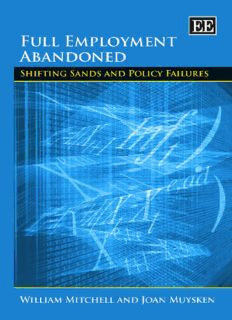
Full Employment Abandoned: Shifting Sands and Policy Failures PDF
Preview Full Employment Abandoned: Shifting Sands and Policy Failures
Full Employment Abandoned Full Employment Abandoned Shifting Sands and Policy Failures William Mitchell Professor of Economics,Centre of Full Employment and Equity, University of Newcastle,NSW,Australia and Joan Muysken Professor of Economics,CofFEE-Europe,University of Maastricht, The Netherlands Edward Elgar Cheltenham,UK • Northampton,MA,USA © William Mitchell and Joan Muysken 2008 All rights reserved.No part of this publication may be reproduced,stored in a retrieval system or transmitted in any form or by any means,electronic, mechanical or photocopying,recording,or otherwise without the prior permission of the publisher. Published by Edward Elgar Publishing Limited Glensanda House Montpellier Parade Cheltenham Glos GL50 1UA UK Edward Elgar Publishing,Inc. William Pratt House 9 Dewey Court Northampton Massachusetts 01060 USA A catalogue record for this book is available from the British Library Library ofCongress Cataloguing in Publication Data Mitchell,William,1952– Full employment abandoned :shifting sands and policy failures / William Mitchell,Joan Muysken. p. cm. Includes bibliographical references and index. 1.Full employment policies.2.Unemployment.3.Employment (Economic theory) I.Muysken,J.II.Title. HD5706.M575 2008 331.12′042—dc22 2007039446 ISBN 978 1 85898 507 7 Printed and bound in Great Britain by MPG Books Ltd,Bodmin,Cornwall Contents List of figures vi List of tables vii List of abbreviations viii Acknowledgements x PARTI FULL EMPLOYMENT:CHANGING VIEWS AND POLICIES 1 The full employment framework and its demise 3 2 Early views on unemployment and the Phillips curve 23 3 The Phillips curve and shifting views on unemployment 49 4 The troublesome NAIRU:the hoax that undermined full employment 81 PARTII FULL EMPLOYMENT ABANDONED:SHIFTING SANDS AND POLICY FAILURES 5 The shift to full employability 123 6 Inflation first:the new mantra of macroeconomics 146 7 The neglected role of aggregate demand 163 PARTIII THE URGENCY OF FULL EMPLOYMENT: FOUNDATIONS FOR AN ACTIVE POLICY 8 A monetary framework for fiscal policy activism 205 9 Buffer stocks and price stability 224 10 Conclusion:the urgency of full employment 260 References 267 Index 289 v Figures 1.1 The pillars of the full employment framework 8 1.2 Unemployment rates,Australia,Europe and the United States,1950–2006 10 1.3 The full employability framework 16 2.1 The classical labour market 25 4.1 The determination of the NAIRU by the BRW and PRW curves 84 4.2 Unemployment and vacancies,sectoral and aggregate shocks 103 4.3 Unemployment and vacancies,equilibrium on the labour market 107 5.1 The full employability framework 126 6.1 Inflation and inflation expectations,Australia,1974–2004 155 6.2 Summary average sacrifice ratios 160 7.1 Employment gaps,selected countries,1960–2005 177 7.2 Employment growth and GDP growth for eight OECD countries,1960–2006 179 7.3 Average employment growth and GDP growth for eight OECD countries,1960:1–1973:3,1973:4–1991:4, 1992:1–2006:1 183 7.4 The official unemployment rate and OECD NAIRU estimates,selected countries,1970–2006 185 7.5 Difference- and trend-stationary processes and persistence 187 7.6 Unemployment and labour demand (inverted) for eight OECD countries,various periods 193 7.7a Current and lagged unemployment,1960–2006 197 7.7b Current and lagged vacancies,1960–2006 199 7.8 Layoffs,quits and hiring rates,Canada,1978–1994 200 8.1 The essential government and non-government structure 206 8.2 Vertical and horizontal macroeconomic relations 214 vi Tables 7.1 Misery index (%),selected OECD countries,1960–2006 166 7.2 Components of the MI,selected OECD countries,1960–2006 167 7.3 Inflation as a percentage of misery,selected OECD countries, 1960–2006 169 7.4 Underemployment,males,females,persons,selected OECD countries,various periods,per cent of the labour force 171 7.5 Comparison of the MI and the AMI,various OECD countries,1985,1995 and 2005 (%) 173 7.6 Characteristics of OECD NAIRU estimates,selected countries,1970–2006 186 7.7 Shifting AR parameters for OECD unemployment rates, various periods 189 7.8 AR(1) estimates for unemployment and the NAIRU,selected countries,1970:3–1995:1 and 1995:1–2006:4 190 8.1 Central bank balance sheet 217 9.1 A comparison of selected national employment creation schemes with the JG ideal 257 vii Abbreviations AMI augmented misery index AR autoregressive process BER buffer employment ratio BRW bargained real wage BSE buffer stock employment CLMI CofFEE labour market indicators CofFEE Centre of Full Employment and Equity CPI consumer price index EC European Commission ECB European Central Bank EES European Employment Strategy ELR employment of last resort EMU European Monetary Union EPWP Expanded Public Works Programme EU European Union FOMC Federal Open Market Committee GBC government budget constraint GDP gross domestic product HP Hodrick–Prescott Filter HPM high powered money ICLS International Conference of Labour Statisticians ILO International Labour Organisation IMF International Monetary Fund IS–LM investment–savings,liquidity–money supply JG job guarantee LNJ Layard,Nickell and Jackman MI misery index NAIBER non-accelerating inflation rate buffer employment ratio NBER National Bureau of Economic Research NAIRLU non-accelerating inflation rate of labour underutilisation NAIRU non-accelerating inflation rate of unemployment NGO non-governmental organisation NK new Keynesian NKPC new Keynesian Phillips curve NREGS National Rural Employment Guarantee Act viii Abbreviations ix NRU natural rate of unemployment OECD Organisation for Economic Cooperation and Development OPEC Organisation of the Petroleum Exporting Countries PRW price-determined real wage PSE public service employment SGP Stability and Growth Pact UK United Kingdom US United States UV unemployment to vacancies curve (Beveridge curve)
Description: